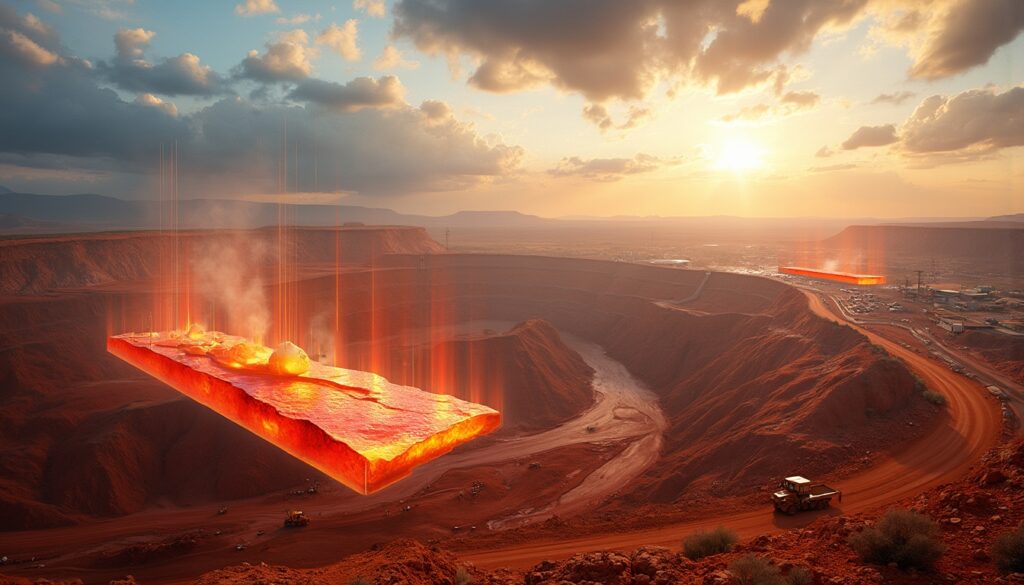The Mt Bevan Project is advancing according to schedule, with several key milestones already achieved in early 2025. Key steps for Rinehart Mt Bevan guide the project’s progress, as the team submits its mining lease application on February 15, 2025.
This submission marks the upgrade from the exploration license, a transition that underlines confidence in the resource’s commercial viability.
The project’s progress is driven by a series of regulatory approvals and technical reviews. The joint venture partners are advancing multiple license applications simultaneously.
These include permits for groundwater exploration, extractions in Western Australia’s arid regions, and approval for new transport corridors.
In parallel, the team is focused on advancing expert insights on economic viability and feasibility studies in mining.
Such insights help streamline the process as the project transitions from exploration to full-scale development.
A further catalyst for the project’s momentum is its strategic timing. Industry analysts note that Mt Bevan’s accelerated development timeline is approximately 18 months faster than the median for similar magnetite projects in the region.
This efficiency supports the overall objectives of the initiative, aligning perfectly with navigating mining investment strategies and geological insights.
Gina Rinehart’s influence is evident as the project continues to follow key steps for Rinehart Mt Bevan.
Her company's reputation, bolstered by ventures like rinehart's significant investment, reinforces the confidence in reaching final investment decisions.
The upcoming phase includes comprehensive environmental and heritage surveys.
Scheduled for late March or April 2025, these surveys cover roughly 12,000 hectares. The collaboration with the Noongar Aboriginal Corporation ensures that cultural heritage management remains a priority.
Advanced technology will support these assessments.
For example, the project utilises AI-driven fauna tracking systems to reduce environmental impact—a technique that adds a layer of sustainability to the operations.
This approach complements the role of sustainable mining in reducing carbon emissions.
Technical studies play an important role in the Mt Bevan Project.
Stage one feasibility studies, completed in Q4 2024, paved the way for sophisticated geotechnical modelling of the 1.29-billion-tonne deposit using Leapfrog Geo software.
These studies are essential for understanding the JORC code for informed mining investments.
The project is charted to progress to a full feasibility study by Q3 2025.
Benchmarking suggests that if timelines remain on track, first ore production could commence by Q4 2027.
This schedule includes a 24-month feasibility period and an 18-month construction phase.
Who Are the Key Players in the Mt Bevan Project?
The joint venture is headed by two prominent mining companies. Legacy Iron Ore owns a 36.57% stake and brings 14 years of local expertise in the Yilgarn region.
Its involvement adds considerable regional understanding and operational experience to the project.
The majority partner, Hancock Magnetite, controlled by Gina Rinehart, holds 63.43% of the project.
As part of Hancock Prospecting, with revenues of $16.8 billion in FY2024, Hancock brings significant financial clout and industry influence.
Gina Rinehart has emphasised that this project is one of the key steps for Rinehart Mt Bevan, reinforcing its strategic importance.
The project governance includes a Technical Committee of three Hancock appointees and two Legacy representatives.
This balanced structure mirrors successful models, such as the Roy Hill project, and ensures effective oversight of project milestones.
Legacy CEO Rakesh Gupta, with over 20 years of magnetite experience, has been instrumental in keeping the project on track.
His expertise in processing magnetite adds critical value to the operational strategy.
This collaboration combines local knowledge and financial strength to drive the project’s success.
What Makes Mt Bevan a Significant Iron Ore Project?
Mt Bevan is notable for its massive 1.29-billion-tonne resource estimate and its capacity to produce direct reduced iron (DRI) at a grade of around 70% iron.
This grade far exceeds the global standard of 62% in comparable hematite projects.
High-grade DRI has huge benefits for sustainable steelmaking.
According to the Steel Sustainability Institute, DRI-grade ore can reduce blast furnace emissions by 30%.
Moreover, the deposit’s low alumina content (under 2%) improves processing efficiency.
Geologist Dr Emma Warren has noted the advantages of such a high-quality ore body.
The location in Western Australia’s Yilgarn region also provides strategic benefits.
The project utilises established infrastructure corridors to address a significant production gap.
Following the closure of Mineral Resources’ operations in December 2024, Mt Bevan’s target of 15Mtpa will more than compensate for previous market losses.
Mt Bevan also leverages advanced technology in its beneficiation process.
Specifically, High-Pressure Grinding Rolls (HPGR) are expected to reduce energy use by 20% compared to conventional methods.
This technological drive plays a vital part in australia’s clean energy revolution in mining decarbonisation.
What Environmental and Regulatory Steps Are Required?
The pathway to production includes navigating a complex regulatory framework.
A mining lease application submitted in February 2025 sets the stage for further approvals.
Groundwater management is crucial.
The project requires four groundwater permits, supported by detailed MODFLOW simulations forecasting less than 0.5% drawdown on regional aquifers.
According to the Environmental Protection Authority, this approach sets a benchmark for arid-region projects.
Heritage surveys constitute yet another regulatory pillar.
Scheduled to cover 12,000 hectares, these surveys run in partnership with the Noongar Aboriginal Corporation.
Such engagement is a proactive measure compared to past controversies in other mining projects.
Transport corridor approvals form an additional requirement.
A 145-kilometre rail spur to the Port of Esperance falls under this remit.
The projected capital expenditure for this infrastructure is approximately $900 million, with multiple environmental assessments in place.
A rehabilitation bond of $85 million will be held in escrow under Western Australia’s Mining Act 1978.
This measure ensures funds are available for eventual site restoration, emphasising the project's commitment to responsible development.
Why Is Mt Bevan Important for the Australian Iron Ore Industry?
Mt Bevan is set to transform Australia’s iron ore sector.
At current prices of $120 per tonne, its estimated export value could reach $1.2 billion annually.
Moody’s analysis even suggests a potential contribution of 0.4% to national GDP by 2030.
The project is also pivotal for the economic revitalisation of the Yilgarn region.
Following the closure of local operations in December 2024, Mt Bevan is projected to create about 1,200 construction jobs and 450 permanent roles.
This job creation underscores the broad economic benefits of the venture.
Mt Bevan is particularly significant for sustainable steelmaking.
The higher-grade iron ore suits modern green steel processes, securing Australia’s role within emerging low-emission markets.
Federal Resources Minister comments have reinforced that such projects are among the key steps for Rinehart Mt Bevan.
Infrastructure investments further support the nation’s competitive edge.
For example, the planned rail spur enhances export capacity and throughput.
This asset, along with lower CO₂ operating costs compared to traditional operations, bolsters Australia’s resource credentials.
Furthermore, rinehart on the hunt for lithium illustrates broader ambitions in sustainable mineral development.
What is the current status of the Mt Bevan project?
The project is proceeding as scheduled. The mining lease application was submitted in February 2025, with environmental and heritage surveys set to begin by April 2025. Early-stage feasibility studies have been completed, setting the stage for full feasibility work in Q3 2025.
What is the significance of Mt Bevan’s iron ore grade?
The deposit can produce direct reduced iron (DRI) at roughly 70% iron compared to a 62% global average. This higher grade improves energy efficiency and reduces CO₂ emissions during steelmaking.
When is production expected to begin?
Industry benchmarks forecast first ore production by Q4 2027. This timeline includes a 24-month feasibility period followed by an 18-month construction phase. Regulatory approvals over 18–24 months have been factored into this schedule.
How does Mt Bevan compare to other Australian iron ore projects?
Mt Bevan stands out for its premium grade and scalability.
Although modest compared to some giant Pilbara projects, its 15Mtpa target replaces recently lost capacity and offers a competitive edge in a greener, low-emission market.
What is magnetite iron ore and why is it valuable?
Magnetite (Fe₃O₄) can be processed to yield high-grade DRI exceeding 68% iron content.
This quality commands a premium price in global markets while supporting lower-emission steelmaking processes. Advanced HPGR technology, which reduces energy use by 20%, further enhances its value.
Key steps for Rinehart Mt Bevan continue to shape the strategic progress of this project.
Their repeated focus illustrates the synergy of technical expertise, regulatory rigour, and sustainable practices driving Australia’s mining transformation.
Want to Stay Ahead of Major Mineral Discoveries?
Discovery Alert's proprietary Discovery IQ model instantly notifies investors of significant ASX mineral discoveries like Mt Bevan, turning complex data into actionable insights that could generate substantial returns. Visit Discovery Alert's discoveries page to understand how major mineral findings historically deliver exceptional market outcomes.




